News from Borneo: Vol. 4
A total of eighteen employees of ITOCHU and Group companies from Tokyo, Sendai and Taiwan came together for the 4th Borneo tree-planting tour at the ITOCHU Group Forest for Orangutans in Sabah State on the island of Borneo in Malaysia. At the site, the participants worked up a sweat, planting 10 to 27 saplings per person in the tough environment as the scorching heat of the sun beat down on them. Here, we introduce the abundant attractions of the local natural environment and a summary of the tour.

North Ulu Segama

This is the reforestation area for this project. We are supporting 967 hectares (slightly larger than a 3 km x 3 km square area) for forest regeneration. It is the largest site for tree-planting supported by a general corporation.
Sukau

This is a popular location for cruises on the Kinabatangan River, and a place where you can come across many wild animals such as crocodiles and proboscis monkeys.
Sandakan

Sandakan is the second city after Kota Kinabalu. It flourished as trading post and as the heart of British North Borneo until 1947 when the capital was moved to Kota Kinabalu.
Sepilok
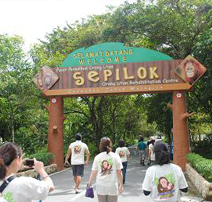
The Orangutan Rehabilitation Centre, which returns orangutans on the verge of extinction to the wild, is located here.
Lahad Datu

We left Kota Kinabalu by propeller plane to travel to Lahad Datu. At the hotel, we got ready to leave for the tree planting site. Staff from WWF Malaysia gave a talk in one of the hotel conference rooms at Lahad Datu.
Tree-Planting Tour
Itinerary
Video of the tour
Reforestation Status as of November 2012
As of November 2012, approximately 690 hectares, or 70%, of the total 967 hectares had been planted with trees. Long spells of rain, droughts and other bad weather have made it difficult for the tree planters to work efficiently. As of now, the tree planting will continue until fiscal 2014 with maintenance work continuing until fiscal 2016. From then on, the site will be left to grow naturally.


by 2011.

grown to 4 meters.
Tree-planting Report
Day 2 (November 23)
Arriving at the hotel after a long flight and transfer, the participants immediately headed for the conference room where they listened to a lecture by WWF Malaysia staff about the current situation in the disappearing forests on Borneo.

by WWF Malaysia staff


After the ITOCHU activities, Mr. Taniyama, a former managing director of ITOCHU who now lives in Kota Kinabalu, came with his wife to talk about local afforestation and culture. The participants were able to get a full understanding of the current situation.
Day 3 (November 24)
The temperature was about 35 degrees. Under the scorching hot rays of the sun, 19 people split into six groups and planted 10 to 27 saplings each. Sweating hard as they planted the trees, everyone worked until they were worn out.
I was moved by participants who, finding traces of orangutan nests at the afforestation site, worked while praying that the trees they were planting would grow to provide homes for the orangutans in ten years’ time.

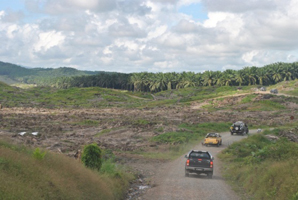




After finishing the tree-planting, we went by bus back to the hotel. The people participating in the evening cruise from the hotel in Sukau encountered proboscis monkeys, orangutans, lizards, kingfishers and other wild animals. After the evening meal, there was also a night cruise. The species of animals you can observe changes between dusk and nighttime. We traveled downstream at night through a magical landscape that took our breath away as we enjoyed the scenery under a starry sky.
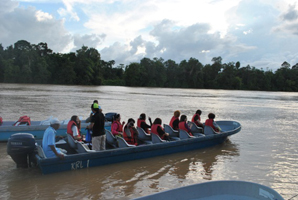
hotel in Sukau where the evening cruise started.



Day 4 (November 25)
With the excitement of the previous day still lingering, we set off on the morning cruise. We also encountered wild animals on the 2.5 hour boat trip and the participants were astonished beyond their expectations.




Day 5 (November 26)
It had been raining heavily since the previous night, so in the morning we paid a visit in the rain to the Sepilok Orangutan Rehabilitation Center. The center shelters orphaned orangutans who have lost their mothers to poachers and, with a little help from human beings, they learn the necessary skills for surviving on their own before they are returned to the wild. It was a valuable few hours with each participant thinking deeply about the connections between forest regeneration and ecosystem protection, and their importance.
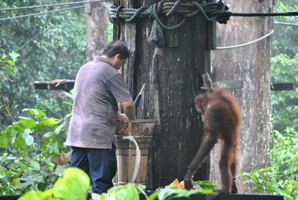
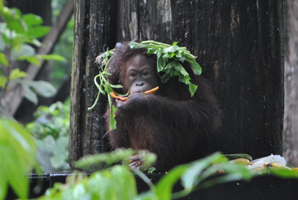


at the resource center

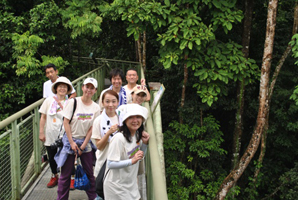
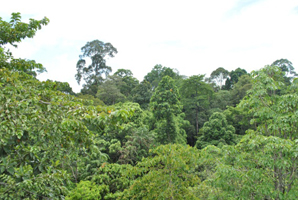


(The photo shows the Chinese cemetery.)

Corporates & Partners, Fundraising & Marketing Division, WWF Japan
The rain is holding off?! The power of people who bring out the sun!
The volunteer tree-planting tour has come to an end without any difficulties thanks to the participants. Once again, I would like to thank you for your support.
At the lecture immediately after arrival, nobody looked tired, rather everyone was excited to participate in the activities. After the presentation, there were a lot of questions and the high level of interest in this project was tangible.
Locally, this is the rainy season, but the men and women from the ITOCHU Group seemed to bring the sun with them. Just like last year, the sky was blue during the time spent at the project site. The temperature rose above 35ºC under the blazing sun, but everyone was smiling and working earnestly without stopping. The people I remember best are the ones who talked to the saplings while gently planting them in the ground. Seeing the look of satisfaction on their faces after the tree-planting was finished, the staff gradually relaxed and had an enjoyable time taking photographs and talking with everyone.
I believe that everyone who participated in this tour came to understand the range of issues around the need for the forest reforestation project, its content and initiatives, as well as the day-to-day activities of the staff. Please do talk to your colleagues, family members and friends about this experience. I expect that your stories will be instrumental in getting people to think about protecting the global environment.






